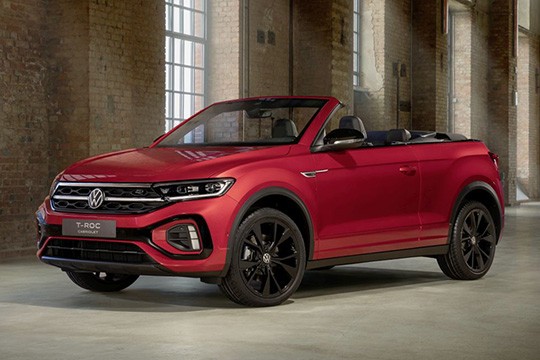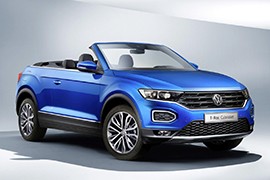VOLKSWAGEN T-Roc Cabriolet Models/Series Timeline, Specifications & Photos
First production year: 2019
Engines: , Gasoline
Body style: SUV (Sports Utility Vehicle)
Volkswagen introduced an updated version of the T-Roc Cabriolet in 2022, along with the rest of the range, giving the car a fresh look and an updated interior.
After Land Rover and Nissan failed to impress with their open-top versions of the Evoque and Murano, respectively, most people involved in the automotive scene didn’t expect to see something like that again. And yet, Volkswagen dared to do that in 2019. Moreover, it even updated it for the 2022 model year, along with the rest of the T-Roc range.
Some of the most significant upgrades of the car were noticed at the front fascia. Volkswagen installed new LED headlights. The grille between them sported a new chromed horizontal slat that visually connected the upper DRLs that doubled as turn signals. On the lower bumper, depending on the options and packages, customers had the option of a second set of daytime running lights installed in the side scoops. These had a vertical layout with three light blocks.
From its profile, there were no significant changes compared to its non-facelifted sibling. The car ran on 16-inch alloy wheels with an option for 17- or 18-inch sets. Vehicles fitted with the R-Line package sported specific badges on the front fenders. One of the car’s particularities compared to the rest of the T-Roc range was that it was slightly longer and featured an extended wheelbase. In addition, it only had two doors, which were longer than the front ones from its five-door siblings. Out back, Volkswagen couldn’t help itself not to install fake exhausts under the bumper, but they kind of blended in into the rear apron. Finally, as a last detail, the car sported a small lip spoiler on the trunk’s lid.
Inside, customers found an entirely new dashboard that featured an eight-inch TFT display in the instrument cluster. It replaced the previously used analog dials. A 10.25-inch screen named Digital Cockpit Pro was also available as an option. Volkswagen installed an eight-inch touchscreen on the center stack. Between the front seats, the automaker installed a narrow center console that housed the gear stick or the gear selector (for the automatic transmission versions). In the back, a bench seat profiled for two was good enough for short jaunts, and the legroom was adequate even for adults. Volkswagen didn’t want to create a retractable hard-top vehicle, so it installed a three-layer canopy for the T-Roc Cabriolet. Last but not least, behind the car, Volkswagen added a 285 liter (10 cu-ft.) trunk, similar in size to those of a small-sized hatchback.
Under the hood, Volkswagen installed a choice of two turbocharged gasoline engines. The lower-spec one was a one-liter inline-three unit, while the other option was a 1.5-liter inline-for. While the former was available only paired with a six-speed manual, the latter could also be mated to a seven-speed automatic.
Volkswagen had a long history of producing convertibles, but after the low sales of the Beetle Cabrio and the Eos, the automaker was reluctant to offer one until the T-Roc Convertible appeared.
The German automaker unveiled the open-top version of the T-Roc in September 2019 and planned the commercial launch for the spring of 2020. But then, the world started struggling with the pandemic that sent everyone home, and the streets were deserted. And yet, in April, true to its words, the German automaker launched the T-Roc Cabriolet as an alternative to its closed-body version of the regular T-Roc crossover. The new model was redesigned from the ground up and shared only its front side, up to the A-pillars, with its brother. It was a bold movement for the German automaker who considered that it could afford to try this move. While the result was not a hard-core SUV nor a sexy-looking open-top grand tourer, it was a well-suited boulevard courier able to crawl over a curb and small enough to fit in tight parking spots.
At the front, the T-Roc convertible shared the same front fascia as its five-door sibling. It featured a broad black grille crossed by horizontal slats that supported the VW badge in the middle. The headlights were standard with halogen bulbs, while the automaker offered an option for LED ones. Lower, in the apron, the automaker added a second air intake that helped to cool the engine and a set of angular-shaped fog lamps.
From its profile, the T-Roc Cabriolet revealed its thick A-pillars that served as rollover protection. Volkswagen reshaped the bodywork by adding longer doors than those installed on the closed T-Roc version. As a result, the rear quarter panels were new but featured the same design idea of enlarged shoulders over the wheel arches. One of the carmaker’s challenges was to create the vehicle without a B-pillar. Thanks to its experience in creating cabriolets, it did that by reinforcing the T-Roc’s floor. Furthermore, the wheelbase had to be extended to make room for the retractable rag-top. As a result, the car’s overall weight increased by 194 kg (428 lbs.) compared to its closed-top sibling.
The T-Roc Cabriolet offered an actual four-seat cabin to its customers. At the front, they discovered bolstered seats and a modern-looking dashboard that integrated a standard touchscreen infotainment system. Its mixed instrument cluster featured analog dials and displays that showed data from the car’s onboard computer. Customers could also opt for an 11.7-inch screen, known as the Digital Cockpit. Those seated in the back could enjoy just enough legroom, especially for short trips inside the city. Like most convertibles from its era, the T-Roc Cabriolet could be opened and closed while driving at speeds of up to 30 kph (19 mph) in nine and eleven seconds, respectively.
Volkswagen limited the engine choice for the T-Roc cabriolet to just two: a one-liter inline-three and a 1.5-liter four-banger. Both were paired with six-speed manuals, while the latter was available with a seven-speed automatic (dual-clutch) gearbox as an option. Power went to the front wheels only.

